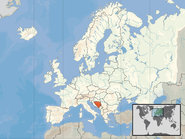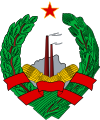Portal:Bosnia and Herzegovina
Welcome to the Bosnia and Herzegovina Portal
 |
 |

| |
The area has been inhabited since at least the Upper Paleolithic, but evidence suggests that during the Neolithic age, permanent human settlements were established, including those that belonged to the Butmir, Kakanj, and Vučedol cultures. After the arrival of the first Indo-Europeans, the area was populated by several Illyrian and Celtic civilizations. The ancestors of the South Slavic peoples that populate the area today arrived during the 6th through the 9th century. In the 12th century, the Banate of Bosnia was established; by the 14th century, this had evolved into the Kingdom of Bosnia. In the mid-15th century, it was annexed into the Ottoman Empire, under whose rule it remained until the late 19th century; the Ottomans brought Islam to the region. From the late 19th century until World War I, the country was annexed into the Austro-Hungarian monarchy. In the interwar period, Bosnia and Herzegovina was part of the Kingdom of Yugoslavia. After World War II, it was granted full republic status in the newly formed Socialist Federal Republic of Yugoslavia. In 1992, following the breakup of Yugoslavia, the republic proclaimed independence. This was followed by the Bosnian War, which lasted until late 1995 and ended with the signing of the Dayton Agreement.
The country is home to three main
Bosnia and Herzegovina is a developing country and ranks 74th in the Human Development Index. Its economy is dominated by industry and agriculture, followed by tourism and the service sector. Tourism has increased significantly in recent years. The country has a social-security and universal-healthcare system, and primary and secondary level education is free. It is a member of the UN, the Organization for Security and Co-operation in Europe, the Council of Europe, the Partnership for Peace, and the Central European Free Trade Agreement; it is also a founding member of the Union for the Mediterranean, established in July 2008. Bosnia and Herzegovina is an EU candidate country and has also been a candidate for NATO membership since April 2010. (Full article...)
Selected article -
The Federation of Bosnia and Herzegovina is one of the two entities composing Bosnia and Herzegovina, the other being Republika Srpska. The Federation of Bosnia and Herzegovina consists of ten autonomous cantons with their own governments and legislatures.
The Federation was created by the 1994General images
-
The assassination of Archduke Franz Ferdinand of Austria and Sophie, Duchess of Hohenberg by Gavrilo Princip in Sarajevo, 28 June 1914 (from Bosnia and Herzegovina)
-
Alija Izetbegović during his visit to the United States in 1997. (from History of Bosnia and Herzegovina)
-
TheHerzegovina Uprising of 1875–77 (from History of Bosnia and Herzegovina)
-
Dissolution of Yugoslavia (from Bosnia and Herzegovina)
-
The Central Bank of Bosnia and Herzegovina in Sarajevo (from Bosnia and Herzegovina)
-
"Keep/Protect Yugoslavia" (Čuvajte Jugoslaviju), a variant of the alleged last words of King Alexander, in an illustration of Yugoslav peoples dancing the kolo. (from History of Bosnia and Herzegovina)
-
"Keep/Protect Yugoslavia" (Čuvajte Jugoslaviju), a variant of the alleged last words of King Alexander I, in an illustration of Yugoslav peoples dancing the kolo (from Bosnia and Herzegovina)
-
2nd c.Bosanski Novi (from History of Bosnia and Herzegovina)
-
Bosnian and Herzegovinian Partisans flag (1941-1945) (from History of Bosnia and Herzegovina)
-
Mogorjelo, an ancient Roman suburban Villa Rustica from the 4th century, near Čapljina (from Bosnia and Herzegovina)
-
Tuzla government building burning after anti-government clashes on 7 February 2014 (from History of Bosnia and Herzegovina)
-
Illustration from the French magazine Le Petit Journal on the Bosnian Crisis: Bulgaria declares its independence and its prince Ferdinand is named Tsar, Austria-Hungary, in the person of Franz Joseph, annexes Bosnia and Herzegovina, while the Ottoman Sultan Abdul Hamid II looks on helplessly (from History of Bosnia and Herzegovina)
-
Coat of arms of Bosnia and Herzegovina (from History of Bosnia and Herzegovina)
-
The Jahorina Ski Resort, a 1984 Winter Olympics venue, is the biggest and most popular ski resort in Bosnia and Herzegovina (from Bosnia and Herzegovina)
-
Vedran Smailović, the cellist of Sarajevo. (from Culture of Bosnia and Herzegovina)
-
Territorial evolution of the Bosnian Kingdom (from History of Bosnia and Herzegovina)
-
Coat of arms of the Banate of Bosnia (from History of Bosnia and Herzegovina)
-
Coat of Arms of the Republic of Bosnia and Herzegovina (from History of Bosnia and Herzegovina)
-
The Avaz Twist Tower in Sarajevo, the tallest building in Bosnia and Herzegovina (from Bosnia and Herzegovina)
-
Estimated development of real GDP per capita of Bosnia and Herzegovina, since 1952 (from Bosnia and Herzegovina)
-
Željko Komšić, Croat member of the Bosnian Presidency, and Hillary Clinton, U.S. Secretary of State, 13 December 2011 (from Bosnia and Herzegovina)
-
BHRT headquarters in Sarajevo (from Bosnia and Herzegovina)
-
Kingdom of Bosnia 1377-1463 (from History of Bosnia and Herzegovina)
-
The Emperor's Mosque is the first mosque to be built (1457) after the Ottoman conquest of Bosnia. (from History of Bosnia and Herzegovina)
-
UN troops in front of the Executive Council Building, burned after being struck by tank fire during the siege of Sarajevo, 1995 (from Bosnia and Herzegovina)
-
Bosnia within the Independent State of Croatia (NDH), 1942 (from History of Bosnia and Herzegovina)
-
Coat of arms of the Socialist Republic of Bosnia and Herzegovina (from History of Bosnia and Herzegovina)
-
Hval's Codex, illustrated Slavic manuscript from medieval Bosnia (from Bosnia and Herzegovina)
-
Bosnia and Herzegovina's flag while part of the Socialist Federal Republic of Yugoslavia (from Bosnia and Herzegovina)
-
The Asim Ferhatović Hase Stadium in Sarajevo hosted the opening ceremony of the 1984 Winter Olympics (from Bosnia and Herzegovina)
-
Bosniansomun. (from Culture of Bosnia and Herzegovina)
-
Eternal flame memorial to military and civilian World War II victims in Sarajevo (from Bosnia and Herzegovina)
-
The Banate in 1373, shortly before its elevation to kingdom (from History of Bosnia and Herzegovina)
-
Bosnian meat platter that contains, among other things, ćevapi, which is considered the national dish of Bosnia and Herzegovina (from Bosnia and Herzegovina)
-
Ottoman Bosnia - flag from 1878 (from History of Bosnia and Herzegovina)
-
Tuzla government building burning after anti-government clashes on 7 February 2014 (from Bosnia and Herzegovina)
-
Folk group Costume Dress, Bosnia Herzegovina (from Bosnia and Herzegovina)
-
The railway bridge over the Neretva River in Jablanica, twice destroyed during the 1943 Case White offensive (from Bosnia and Herzegovina)
-
Bosnia in the Middle Ages spanning the Banate of Bosnia and the succeeding Kingdom of Bosnia (from Bosnia and Herzegovina)
-
Administrative division of modern Bosnia and Herzegovina. (from History of Bosnia and Herzegovina)
-
Coat of arms of Bosnia and Herzegovina during Habsburg times. (from History of Bosnia and Herzegovina)
-
Iron Age cult carriage from Banjani, near Sokolac (from Bosnia and Herzegovina)
-
A lamb roast and "kolo" (circle) dancing - Bosnia and Herzegovina, 1895 (from Culture of Bosnia and Herzegovina)
-
The Bosnia Eyalet in 1683 (from Bosnia and Herzegovina)
-
Gimnazija Mostar in Mostar was one of the most academically prestigious educational institutions in Yugoslavia (from Bosnia and Herzegovina)
-
Ivo Andrić with his wife Milica, upon learning he had won the Nobel Prize in Literature (from Bosnia and Herzegovina)
-
Bosnia and Herzegovina consists of the Federation of Bosnia and Herzegovina (FBiH), Republika Srpska (RS) and Brčko District (BD) (from Bosnia and Herzegovina)
More did you know
Cities
- Banja Luka
- Bihać
- Berkovići
- Bijeljina
- Bosanska Krupa
- Bosanski Petrovac
- Brčko
- Brod
- Bugojno
- Cajnice
- Cazin
- Derventa
- Doboj
- Donji Vakuf
- Dubica
- Foča
- Goražde
- Gornji Vakuf
- Gračanica
- Gradačac
- Gradiška
- Ilidža
- Istočno Sarajevo
- Jajce
- Jablanica
- Kakanj
- Kalesija
- Konjic
- Kotor Varoš
- Laktaši
- Livno
- Ljubuški
- Lukavac
- Modriča
- Mostar
- Nevesinje
- Neum
- Novi Grad
- Novi Travnik
- Olovo
- Petrovo
- Prijedor
- Prnjavor
- Sanski Most
- Sarajevo
- Srebrenik
- Srebrenica
- Teslić
- Tešanj
- Travnik
- Trebinje
- Tuzla
- Velika Kladuša
- Visoko
- Vitez
- Zavidovići
- Zenica
- Zvornik
- Živinice
- Žepče
Selected biography -
List of selected biographies
|
|---|
Did you know (auto-generated)

- ... that Ivan Ančić was the first Bosnian Franciscan to use the Latin script to write in his native language?
- ... that a Socialist Youth League candidate in the 1990 Bosnian general election registered his ethnicity as 'Eskimo' as an apparent protest against ethnic registry requirements for candidates?
Subcategories
Related portals
Religions in Bosnia and Herzegovina
Ex-Yugoslav countries
Other countries

















































































